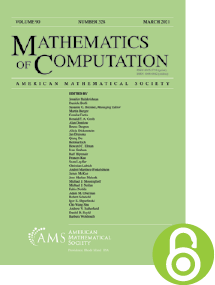Computation of minimal length full Steiner trees on the vertices of a convex polygon
HTML articles powered by AMS MathViewer
- by E. J. Cockayne PDF
- Math. Comp. 23 (1969), 521-531 Request permission
Abstract:
A Steiner minimal tree is a tree of minimal length whose vertices are a given set of points ${a_1}, \cdots ,{a_n}$ in ${E^2}$ and any set of additional points ${s_1}, \cdots ,{s_k}(k \geqq 0)$. In general, the introduction of extra points makes possible shorter trees than the minimal length tree whose vertices are precisely ${a_1}, \cdots ,{a_n}$ and for which practical algorithms are known. A Steiner minimal tree is the union of special subtrees, known as full Steiner trees. This paper demonstrates the use of the computer in generating minimal length full Steiner trees on sets of points in ${E_2}$ which are the vertices of convex polygons. The procedure given is a basis from which further research might proceed towards an ultimate practical algorithm for the construction of Steiner minimal trees.References
- E. J. Cockayne, On the Steiner problem, Canad. Math. Bull. 10 (1967), 431–450. MR 215750, DOI 10.4153/CMB-1967-041-8
- E. J. Cockayne and Z. A. Melzak, Steiner’s problem for set-terminals, Quart. Appl. Math. 26 (1968), 213–218. MR 233286, DOI 10.1090/S0033-569X-1968-0233286-9
- Richard Courant and Herbert Robbins, What Is Mathematics?, Oxford University Press, New York, 1941. MR 0005358
- E. N. Gilbert and H. O. Pollak, Steiner minimal trees, SIAM J. Appl. Math. 16 (1968), 1–29. MR 223269, DOI 10.1137/0116001
- Z. A. Melzak, On the problem of Steiner, Canad. Math. Bull. 4 (1961), 143–148. MR 125466, DOI 10.4153/CMB-1961-016-2 Ivan Niven, Mathematics of Choice, or How to Count Without Counting, Random House, New York, 1965. R. C. Prim, "Shortest connecting networks," Bell System Tech. J., v. 31, pp. 1398—1401.
Additional Information
- © Copyright 1969 American Mathematical Society
- Journal: Math. Comp. 23 (1969), 521-531
- MSC: Primary 05.45; Secondary 65.00
- DOI: https://doi.org/10.1090/S0025-5718-1969-0249323-0
- MathSciNet review: 0249323


